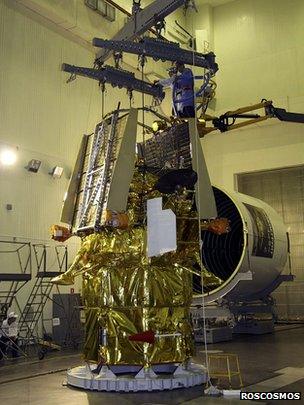Mood grim over Mars probe fault
- Published

Russian scientists were hoping Phobos-Grunt would end a dreadful run of failure for Russia at Mars
Russian space scientists are growing increasingly gloomy about the prospects of saving the country's $170m (£107m) mission to a moon of Mars.
The Phobos-Grunt probe launched successfully on Wednesday but then failed to fire an engine to put it on the correct course to the Red Planet.
The probe is stuck in Earth orbit and engineers may have only days to fix the fault before the batteries run out.
The project is Russia's most ambitious space venture in recent years.
The setback extended a year-long streak of bad luck for the Russian space programme.
Mishaps have included the failure of three satellite navigation craft in December 2010 and the loss of an unmanned space station re-supply ship in August this year.
Officials said that attempts to communicate with Phobos-Grunt ("grunt" means "earth" in Russian) had so far come to nothing.
"The scariest thing in this field is when you get no signal back from the craft," an unnamed source told the RIA Novosti news agency after Thursday's second failed attempt to establish contact with the craft.
"I think we have lost the Phobos-Grunt," Vladimir Uvarov, a former senior space official at the Russian Defence Ministry, told the government daily Rossiyskaya Gazeta.
"It looks like a serious flaw. The past experience shows that efforts to make the engines work will likely fail."
Another official told the Gazeta.ru website: "The chances of it being revived and sent on its way to Mars are extremely small."
If the problem is simply a software issue and engineers can upload new commands, engineers have a chance of rescuing the mission. However, if the fault is rooted in a hardware malfunction, Phobos-Grunt could be doomed.
The recovery efforts are complicated by the fact that the Russian space agency Roscosmos only has a few hours a day to reach the probe due to Russia's limited earth-to-space communications network.
The European Space Agency has now joined the country's long-distance efforts to rescue the dying craft by enlisting its stations in French Guiana and Australia.
One glimmer of hope comes from the observation that the spacecraft is falling back to Earth slightly slower than first suspected.
"It is losing 2km (6,600 ft) a day," a Roscosmos official told the Interfax news agency on condition of anonymity, "If this trend continues ... it could stay up for several weeks or perhaps even a month."
However, he added: "If the (upper-stage) thrusters fail to fire, Phobos-Grunt will soon turn into space junk."
The spacecraft was designed to collect rock and dust samples from Mars' moon Phobos and bring them back for study in labs on Earth.
Scientists hope this debris would shed light on the origin of the 27km-wide moon, which could be a captured asteroid.
The mission is also noteworthy because it is carrying China's first Mars satellite. Yinghuo-1 is riding piggyback on Phobos-Grunt.
The two craft lifted off from the Baikonur Cosmodrome in Kazakhstan on a Zenit rocket at 0016 local time on Wednesday (2016 GMT Tuesday) and were dropped off in an elliptical orbit around Earth 11 minutes later.
Almost two and a half hours into the mission, the huge cruise stage attached to Phobos-Grunt should then have made the first of two firings, to raise the orbit and to send the mission on to Mars. Russian officials say neither of those planned engine burns occurred.
Reports suggest the spacecraft attempted to orientate itself in space using the stars, failed to pick them up and therefore did not execute the firings as planned.
- Published4 November 2011
- Published19 July 2011
- Published21 September 2010